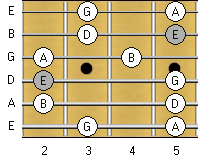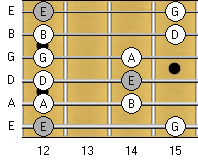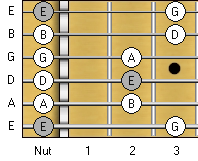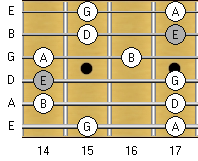In this lesson we’re going to look at a very simple way of expanding your fretboard knowledge. If you’ve been playing scales for a while, then you probably already know about it. But if you’re new to scales, then it’s definitely worth checking out this lesson.
The best way for me to teach this method is to give you some specific examples. So that’s exactly what we’ll do now…
A Couple Of Examples
For the first example, we’ll be looking at Fingering 1 of the E Minor Pentatonic scale…
E Minor Pentatonic: Fingering 1
[Important Side Note: I need to stress here that it’s very important that you memorize the notes of any scale fingering that you learn. Many guitarists just learn the shape. While this is an OK starting point, it doesn’t help you understand the musical structure of the scale. Most other instrumentalists know what notes they are playing when they play scales. I think it’s a great idea for guitarists to know this also!].Please take a few minutes now to play through the scale fingering above. You might even want to say the note names out aloud as you play them. Once you’ve done this, please check out the fretboard diagram below…
The important thing to realize is that this is still the first fingering of the E Minor Pentatonic scale. We’re playing the exact same notes, in the exact same order, on the exact same strings. The only difference is that we’re playing those notes one octave lower. In other words, all the notes have been moved down 12-frets.
Let’s now take a look at another example. For this one we’ll look at Fingering 2 of the E Minor Pentatonic scale…
E Minor Pentatonic Scale: Fingering 2
Please play through this scale fingering quite a few times. Be sure to pay attention to the notes that you’re playing—don’t just mindlessly play the shape. Once you’ve done this, then have a look at the other location where you can play this specific fingering…

Like the first example, what we did is shift all the notes of the fingering down an octave.
A Few Last Words
Like I said earlier, this is a really simple method. But please don’t dismiss it just because it’s simple. It’s a great way of easily improving your fretboard knowledge.
To get the most out of this strategy, I really recommend doing the following for every new scale fingering that you learn…
- Memorize the notes of the scale fingering. Yeah, it’s a pain to do. But it will really help you in the long run. 🙂
- If possible, find the second location on the fretboard where you can play the same scale fingering. You’ll do this by either moving the notes of the fingering down 12-frets, or up 12-frets. Keep in mind that occasionally, if your guitar has less than 24-frets, it won’t be possible to find another location for the fingering.
Have fun!
Return To: Guitar Fretboard Knowledge Lessons


